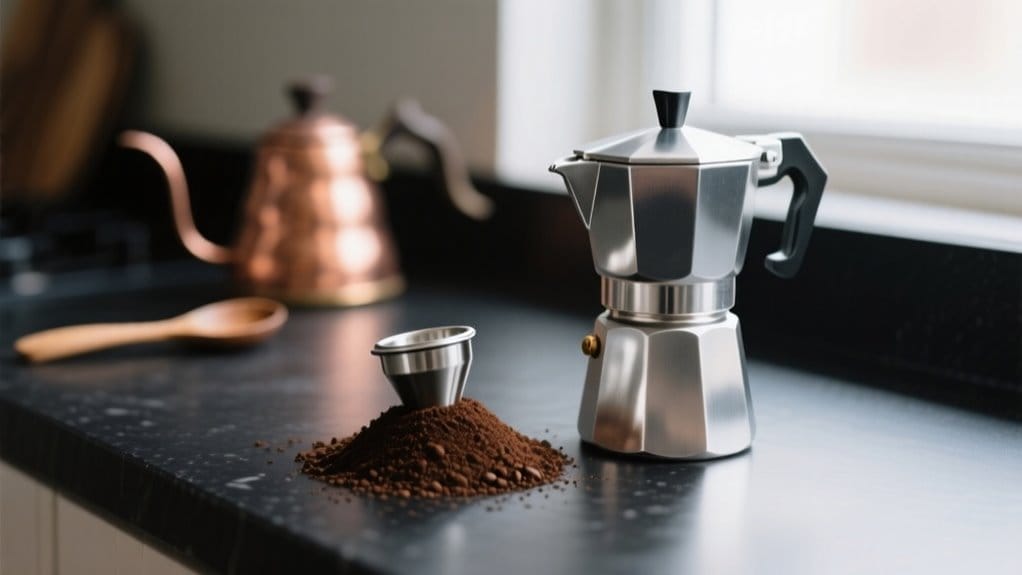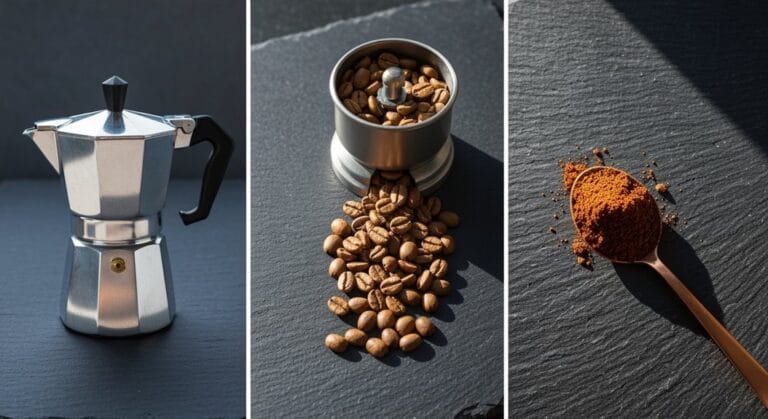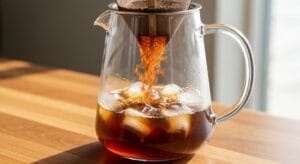The ideal Moka Express grind isn’t rocket science: grab a burr grinder that whispers like a bee, twist it to medium‑fine (about 650 microns, sand‑y not flour‑y), then weigh 16–18 g of beans, give the tray a tap like it owes you coffee, and skip the tamping because the pot prefers hug. If you keeps watching, the pot’s sigh will turn into the next coffee‑lover’s punchline, promising even more brew‑bliss beyond this quick sketch.
Key Takeaways
- Choose a burr grinder (manual or electric) for uniform particles; avoid blade grinders that produce uneven sizes.
- Set the grinder to a medium‑fine setting around 650 µm, keeping particle size between 360‑660 µm for proper flow.
- Measure 16‑18 g of fresh coffee per 3‑cup Moka pot; lightly tap the grounds, no tamping required.
- Verify consistency by ensuring >98 % of particles fall within the target size range, preventing channeling and bitterness.
- Adjust dose or grind size by ±1‑2 g or one click if brew time deviates from the ideal three‑minute extraction.
Selecting the Right Grinder for Your Moka Pot
Although coffee enthusiasts often assume a grinder is just a noisy box, picking the right one for a Moka pot can feel like hunting for a needle in a haystack of beans, and that’s where the drama (and the laughs) begin.
They find that manual models, like the 1Zpresso Q Air, win points for grinder durability and give tactile grind settings that feel like turning a volcano dial.
Electric burrs, such as the Sage Smart Grinder Pro, blast through beans, offering grind settings and consistency, but they can roar louder than a cat! on a hot roof.
The Baratza Encore, praised for durability, lands in the middle, delivering decent settings breaking the bank.
Bottom line: choose your style that matches patience, space, and sense of humor.
Manual grinders offer control over grind size for that perfect Moka pot balance.
Achieving the Ideal Particle Size and Consistency
Almost every moka‑pot enthusiast uncovers—usually after a few tragic mornings of bitter sludge and a panic‑induced “what‑the‑heck‑is‑this?”—that the magic lives in the grind, not the gods.
Moka‑pot mastery? It’s the grind, not the gods, that decides your morning miracle.
They soon learn that a medium‑fine grind texture, roughly 650 microns, hits the sweet spot, while staying between 360 and 660 microns so water can flow without choking the filter. This is particularly crucial because moisture content can impact the overall extraction and flavor profile of the coffee.
Uniformity matters; about 98 % size consistency stops channeling, keeps extraction efficiency high, and avoids the dreaded “sand‑in‑my‑cup” feeling.
Burr grinders deliver that consistency, blade grinders just scatter particles like confetti, leading to bitter bites or weak dribbles. Freshly ground beans preserve aroma, and a quick test—watch brew time hit three minutes—confirms they’re on target, not over‑or under‑extracted. Additionally, understanding the role of espresso as a core ingredient in coffee beverages can enhance your overall brewing experience.
Now the pot sighs in relief, and the morning smiles back.
Fine‑Tuning the Coffee Dose for Balanced Extraction

When the grind ultimately settles at the sweet‑spot—those 650 micron particles that keep the moka‑pot from choking—the real game‑changer sneaks in at the bottom of the basket: how much coffee you actually dump in there.
A typical 3‑cup pot wants 16‑18 g, not a mountain of beans, because under‑dosing makes watery, whiny coffee, while over‑dosing clogs the valve, yields bitter sludge, and makes you question your life choices.
Light tapping levels the grounds, no tamping, just a flat pancake—think pancake, not brick.
Slight dose variation of ±1‑2 g nudges extraction balance, extending brew time a hair or cutting it short, letting you rescue a bitter disaster or a weak flop, respectively.
Consistency is key, so measure, laugh, repeat.
Everybody enjoys a perfect moka, right?
Seriously, try it!
Frequently Asked Questions
How Often Should I Descale My Moka Express?
The moka express should be descaled at least twice yearly, increasing with hard water or heavy use; this descaling frequency is a core maintenance tip, ensuring ideal taste and reliable brewing performance for consistent results.
Can I Use Pre‑Ground Coffee in a Moka Pot?
Studies show 70% of pre‑ground users report weaker flavor, yet they can still brew in a moka pot if they follow Moka pot tips and choose a proper Coffee grind, preferably medium‑fine for consistent results.
Does the Type of Water Affect Moka Coffee Flavor?
Yes; water type influences moka coffee flavor because water hardness and mineral content affect extraction efficiency, acidity balance, and body, potentially producing bitter, flat, or underdeveloped cups depending on mineral concentrations in the brewing water.
What Is the Ideal Brewing Temperature for a Moka Pot?
The ideal brewing temperature for a moka pot is approximately 93 °C (200 °F), a core brewing essential; precise temperature control using low‑medium heat guarantees balanced extraction and avoids bitterness while preserving aromatic compounds and smooth body.
How Long Should I Let the Coffee Sit Before Serving?
It should be served immediately; allowing any pause beyond a few moments risks coffee extraction and loss of serving temperature, as prolonged contact with hot grounds quickly degrades flavor and aroma in the cup generally.





